Argentina is the world’s 8th largest country.
It’s massive.
It’s also incredibly diverse.
There’s a subtropical rainforest, desert landscapes that would make the American Southwest jealous, and do we even need to mention Patagonia?
From north to south, there is a world’s worth of ecosystems contained within the borders of one country and luckily for us, Argentina works hard to protect these natural resources in national parks. They’ve even created a few new ones in the just the past few years!
There are 36 national parks in Argentina (and counting), you can see a map of all 36 here.
In this article I list out the most beautiful ones that will be easiest and most likely to fit into any Argentina itinerary.

QUICK NOTE: This post contains affiliate links and Sol Salute may receive a commission for purchases made through these links, at no extra cost to you.
NOTE ON TOUR OPERATORS: I link to tours on three tour aggregators – GetYourGuide, Viator, and Tangol. All are reputable. I do my best to find the most affordable option of the three but prices and availability can vary.
Argentina National Parks: What to Keep In Mind
This post details the 15 most beautiful Argentina national parks to visit, listed from north to south.
But first, here are a few things to consider:
- Some parks are free to enter and others have an entrance fee.
- Usually when there’s an entrance fee there is a discount if you visit two consecutive days (like Iguazu, Glaciares and Tierra del Fuego), you’ll pay in advance for this so plan ahead.
- Just like anywhere leave the park better than you found it. Pack out your trash, leave no trace, be respectful.
- If you’re an avid hiker, pro tip from me to you is (after searching my blog for the best Argentina hikes, of course), is to check the destinations official tourism website, whether it’s the province or city. They often have helpful lists of the area’s hiking trails and activities.
- Keep seasonality in mind. Not just summer or winter but also rainy versus non-rainy seasons, peak and non-peak seasons. (January and July are very popular local travel months, for example).
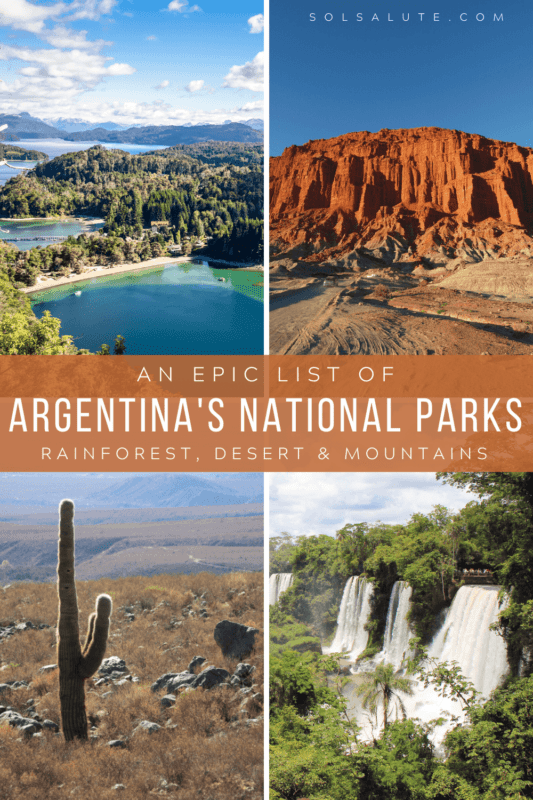
15 Beautiful National Parks in Argentina
Between 36 national parks, even more provincial parks, nature reserves, and even just city parks in Buenos Aires there are countless ways to get outdoors in Argentina.
Out of all these opportunities here are 15 can’t miss national parks to get you started.
1. Iguazú National Park
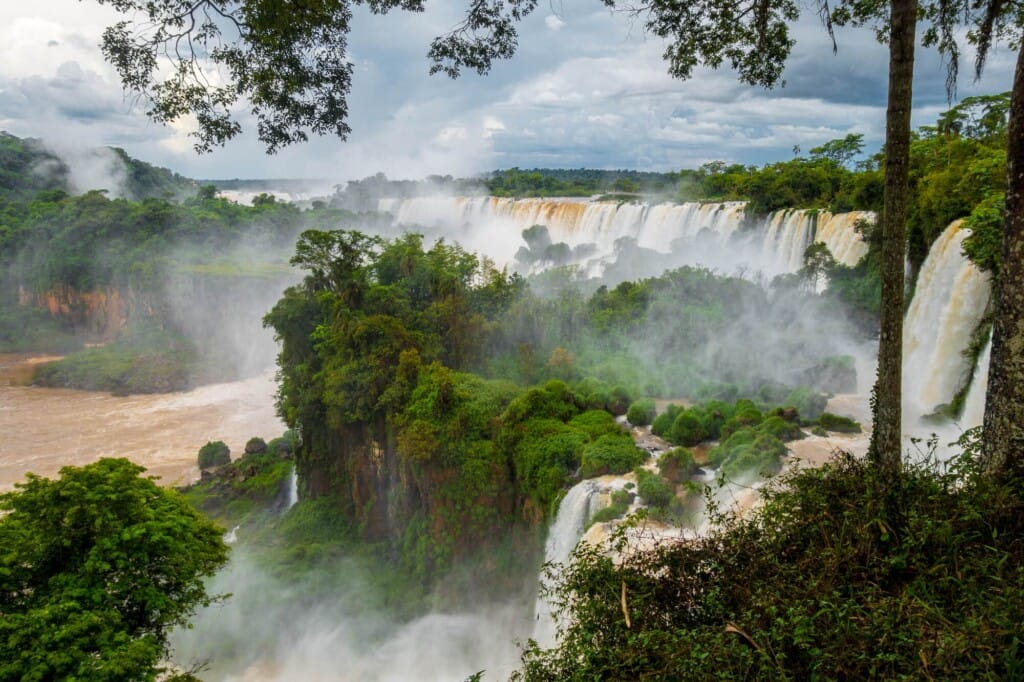
Iguazu is not only first on the list, but first in most people’s minds when they plan their trips to Argentina.
Iguazu Falls in Argentina is one of the country’s most popular destinations.
Even Eleanor Roosevelt agrees. She legendarily exclaimed, “Poor Niagara!” upon visiting Iguazu National Park.
Iguazu is made up of up to 275 individual waterfalls which combine to form the largest waterfall system in the world.
The falls straddle the Argentine and Brazilian border and to get the full experience it’s ideal to visit both sides.
Only have time for one?
Visit Argentina.
The majority of the falls and the bulk of the action are on our side. In contrast, Brazil’s side offers an epic panoramic view of the falls.
I recommend staying for for at least 2-3 days and then continuing on to Mendoza, the Northwest or Patagonia.
Or discover more of Argentina’s rainforest on a road trip through the Misiones province.
When to Visit Iguazu?
Iguazu is a wonderful (and popular) destination year round. But being in the jungle it’s understandable that fall and winter offer the mildest weather.
Argentina’s summer holidays in January will bring a lot of crowds. If planning on visiting then (or during any long weekend), book accommodation well in advance.
If you’ll be lucky enough to be in Iguazu during a full moon, book this full moon walk through the park to see a once in a lifetime view of the falls!
2. Iberá National Park (& Provincial Reserve)

Did you know that Argentina is home to one of the world’s largest wetlands (second only to Brazil’s Patanal)?
Seriously, they cover nearly 13,000 square kilometers, an area nearly the size of Switzerland.
Argentina’s Ibera Wetlands are in the northeastern province of Corrientes.
Use the tiny village of Colonia Carlos Pellegrini as a base for both the national park and the provincial reserve.
To be honest, the provincial reserve has a lot more to offer in ways of infrastructure, guided walking paths, and wildlife.
Luckily, they are next to each other and it’s easy to visit both.
Ibera is a little hard to get to and very much off the beaten path. If you’re wanting to escape the crowds of more popular destinations like Iguazu, this is your best bet.
For a full guide on how to visit the wetlands, read my guide to Ibera.
Once here, you’ll see some of Argentina’s most amazing wildlife, including marsh deer, capybara, caiman, and anaconda.
Pack your binoculars because while sometimes a capybara might stroll right in front of you in the middle of town, other times the animals are further away.
Here’s a list of my favorite travel binoculars.
How Best to Visit Ibera?
When to visit is similar to Iguazu, winter and fall will bring milder temperatures and less humidity. But HOW to visit this remote destination?
Visiting one of the regions top lodges like Rincón del Socorro are the best bet. They tend to offer full packages that take full advantage of the region with tours and excursions included in the rate.
If you want to visit both Ibera and Iguazu together but don’t want to plan your own logistics (these things can often be difficult in Argentina), this package tour is a great option.
3. El Palmar National Park
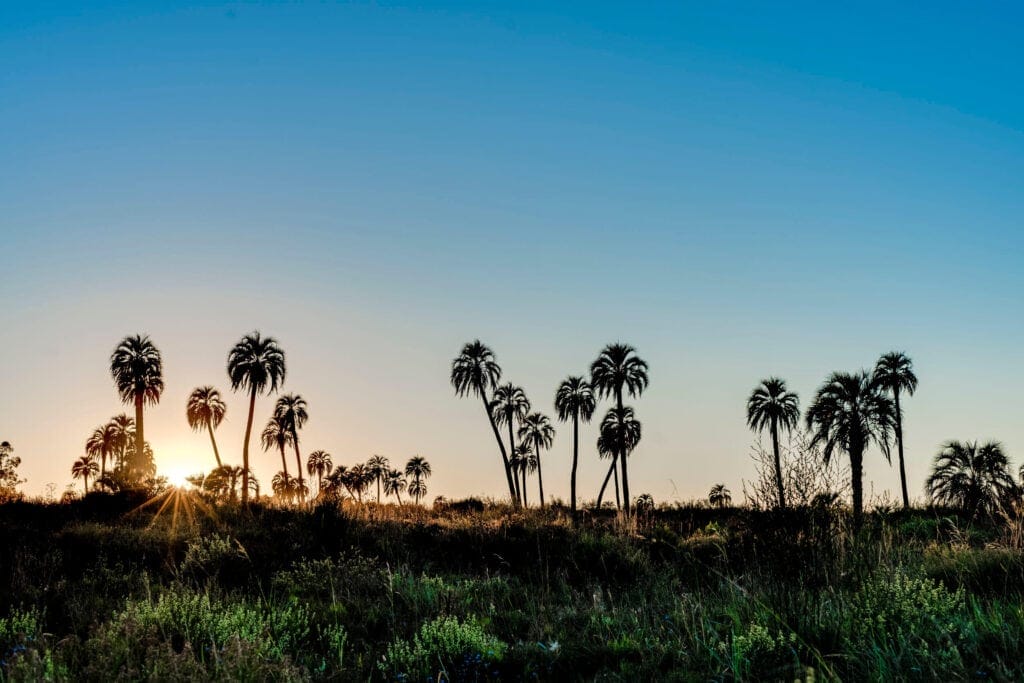
El Palmar is a small national park in Argentina’s Entre Rios province, just a 5 hour drive from Buenos Aires.
It covers just 85 square kilometers and is named after its shining star, the yatay palm tree.
If Ibera is too far out of reach for you, El Palmar is a much more accessible alternative.
It may not offer the same level of diversity in wildlife but you’ll still see plenty of capybaras and excellent bird watching.
El Palmar is in between the small cities of Colon and Concordia so you can look for accommodation in either.
I recommend going in your own vehicle to more easily navigate the park and your accommodation.
Check rental car rates in Buenos Aires here to plan your national park road trip.
4. Calilegua National Park

Argentina’s most northwest province, Jujuy, is famous for its rainbow colored mountains and rugged desert landscapes.
Surprisingly, there’s also a lush, green jungle, highlighting this tiny province’s richness in landscapes and cultures.
Calilegua National Park features jungle, forest and mountainous woods.
The yaguarate (jaguar) resides here along with other wild cat species and stunning bird watching opportunities.
If you love the outdoors, eco-tourism and trekking, you’ll love this park that’s rarely visited by international tourism.
Read Next: A 9 Day Road Trip through Jujuy & Salta: Argentina’s Northwest
When to Visit Calilegua National Park
Winter is the best time to visit Jujuy in general, but particularly this Argentina national park.
Popular hikes like the Termas del Río Jordán are only accessible in winter. Termas del Río Jordán, for example, closes in November when the river is too high and temperatures are too hot.
Spring and Fall are also ideal times for weather. Summer months (December through February) are the rainy season which complicates hikes and any road trip off the paved highways.
5. Los Cardones National Park
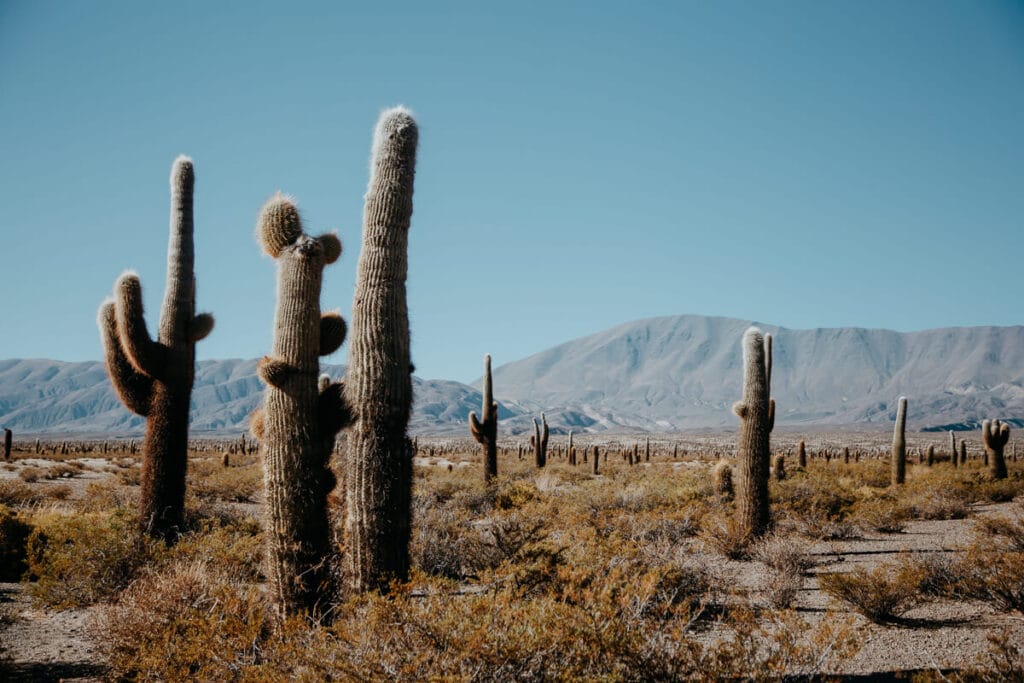
Los Cardones National Park in Salta is just what it sounds like: a national park in Argentina full of cardones (or giant cactus).
These cacti are larger than life and are even more impressive once you realize it took hundreds of years to reach that level of grandeur.
This park is less of a destination in its own right and more of a worthwhile pit stop on a Salta road trip.
Los Cardones is on Ruta 33 between the city of Salta and the town of Cachi.
After weaving through the switchbacks on the Cuesta del Obispo you’ll drive along the straight stretch of highway called the Recta Tin Tin. Parque Nacional de los Cardones lies along the Recta Tin Tin, so avoid the temptation to speed or you’ll miss the views.
Along the highway you’ll pass multiple walking paths with informational plaques about the cardon. These are worth stopping for to learn about the area as well as for photo opportunities.
How to get to Parque Nacional de los Cardones
As mentioned above, this Argentina national park is on Ruta 33 between Salta and Cachi.
This drive is a scenic one and a popular day trip from the city, but I recommend driving your own car if possible.
If you won’t have your own car, take this organized day trip. It will see all of the sites along the way as well as allow time for you to enjoy Cachi.
But if you have the option to rent a car in Salta (check rates here), I cannot recommend it enough. You’ll have more freedom and this region is best seen with your own car.
Read my Salta road trip itinerary and my Salta & Jujuy itinerary for inspiration!
6. Talampaya National Park

Talampaya is in La Rioja and is one of Argentina’s 7 Natural Wonders.
This otherworldly landscape of red earth and deep canyon transports you to Mars.
The best time of year to visit Talampaya is in winter, from June to August.
This part of the country gets extremely hot in the summer months and it’s best to avoid visiting then (you’ve been warned).
Talampaya National Park limits the number of daily visitors and you’re required to reserve ahead of time (which I recommend doing before booking any travel, just in case!).
To visit, reserve one of their three excursions on the official website.
PRO TIP | Ischigualasto Provincial Park in San Juan borders Talampaya. Ischigualasto is another otherworldly landscape, appropriately named Valle de la Luna (Valley of the Moon). You can easily visit both parks on the same day or weekend.
7. El Leoncito National Park

El Leoncito is in the Andean foothills in the San Juan province.
The arid climate here means clear, blue skies and rarely a cloud in the sky, so it’s easy to see why it’s home to two important observatories: the Observatorio El Leoncito (C.AS.LEO) and Observatorio Cesco.
You can organize day visits to the observatories; however, the best experience is obviously to arrange a nocturnal visit to the observatories to see the night sky from their telescopes.
Base yourself in nearby Barreal just 35 kilometers away. With no public transportation you’ll need to rent a car or book a guided trip in town.
8. Lanin National Park
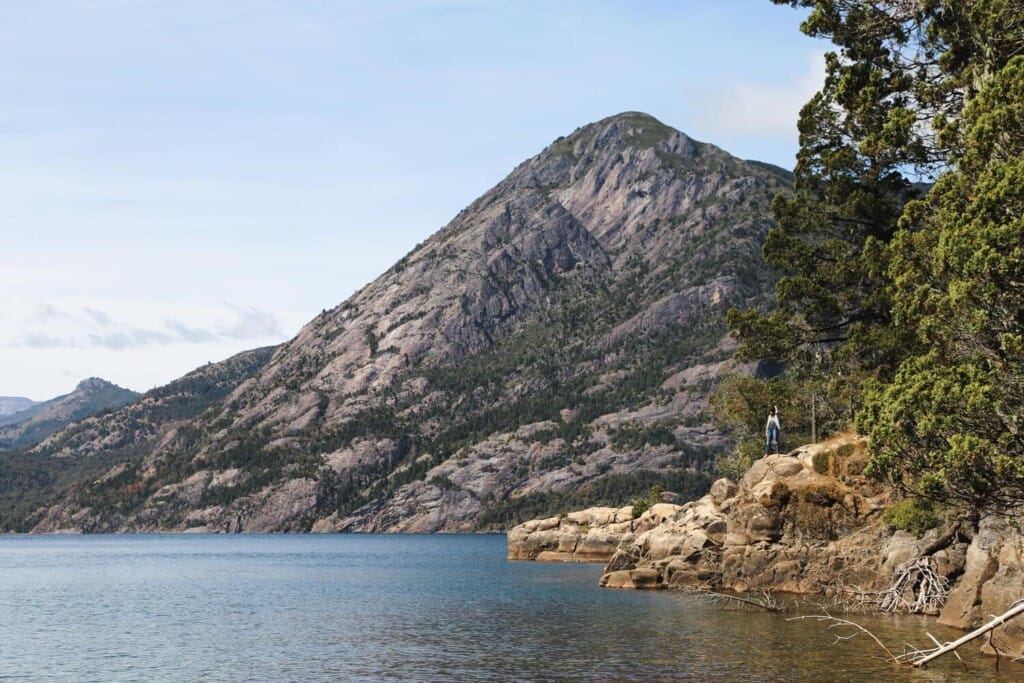
Lanin National Park is in northern Patagonia in San Martin de los Andes.
Its many highlights include beautiful beaches on Lago Lacar, mountain treks, stunning lakes and waterfalls.
Playa Yuco (pictured above) and Quila Quina are my personal favorite areas of this park.
The short all-levels hike to the Cascada Chachin waterfall is a close second.
How to see Parque Nacional Lanin
It’s easiest to have a your own car as there’s no public transport and the high cost of taxis will quickly add up.
Lanin is also home to the northern half of one of Argentina’s most stunning drives, the Ruta de los 7 Lagos.
If you don’t have a car, staying in San Martin de los Andes and taking organized tours makes this a very accessible national park in Argentina.
This boat excursion will show you the main highlights of this national park in one day.
9. Nahuel Huapi National Park
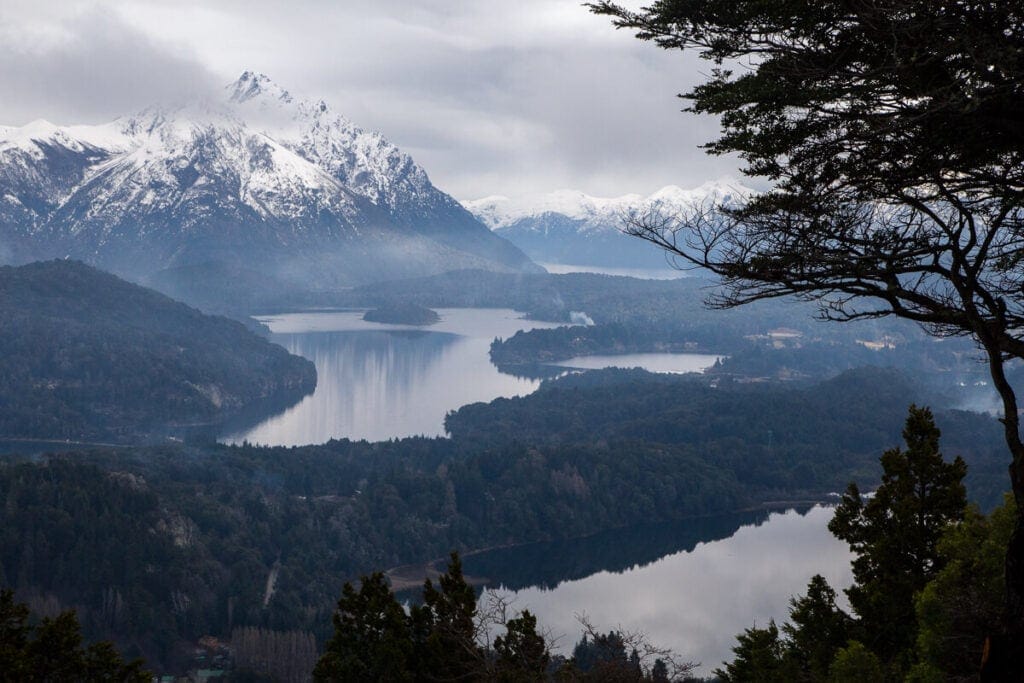
This region of Northern Patagonia is so beautiful that you literally exit one national park only to immediately enter the next.
Lanin ends for Nahuel Huapi to pick right up where it left off.
Nahuel Huapi is stunning and another of Argentina’s official natural wonders.
The main city is the massively popular San Carlos de Bariloche but I recommend using the smaller Villa La Angostura as your base.
It’s more charming than Bariloche and while touristy, of course, there are a lot less people to contend with.
Nahuel Huapi and its surroundings make up Argentina’s lake district, filled with countless lakes of crystal clear, turquoise water.
In the warm summer months you can take a dip, in the winter months I recommend sticking to the ski slopes.
Nahuel Huapi is the oldest national park in Argentina and should definitely be on your bucket list.
10. Los Arrayanes National Park
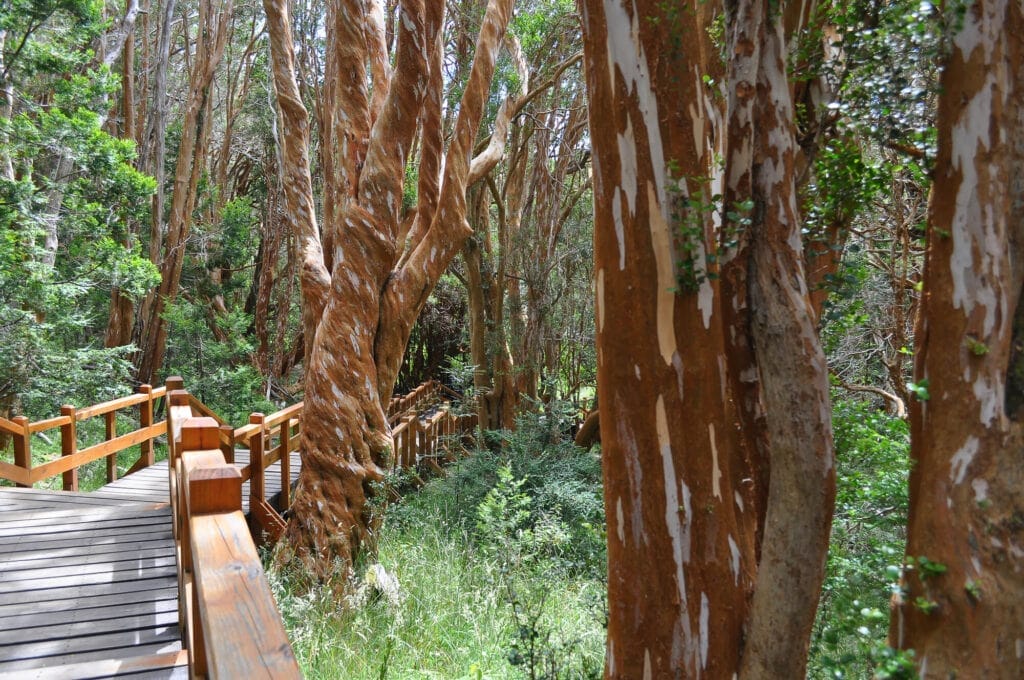
Los Arrayanes is a small park of just 17 square kilometers on the Quetrihué Peninsula just outside Villa la Angostura.
It’s an easy (and popular) day trip from Bariloche, check it out here.
The tour starts with a boat ride across Nahuel Huapi Lake to the peninsula, where you begin a guided tour of the Arrayanes forest.
The red-orange bark on these twisted trunks looks like cinnamon and the forest is completely filled with them.
If you’re in Bariloche, I highly recommend spending an afternoon in Los Arrayanes.
11. Lago Puelo National Park
A few hours south of Bariloche, Lago Puelo (the lake, town, and national park all of the same name) is equally beautiful but attracts far less mass tourism than its big brother to the north.
The woods here house two endangered species of deer, the miniscule pudú (the world’s tiniest deer) and the much larger huemuel. Both are rare sightings so keep your eyes open.
In Lago Puelo, go on the park’s many hikes, take a dip in the turquoise glacial water, go on a horseback ride, or just lounge on the many beaches.
Stay there or in the neighboring town of El Bolsón, a hippie hotspot since the 1960’s.
12. Los Alerces National Park

Moving further south, we reach Los Alerces (just south of Lago Puelo near the city of Trevelin in Chubut).
ITINERARY TIP | Plan an epic Patagonia road trip, starting in Lanin in San Martín de los Andes and driving south to Los Alerces would not disappoint. This itinerary will cover 5 national parks in Argentina in one fell swoop.
Los Alerces is home to some of the most pristine portions of the Patagonian temperate forest, along with even more crystal clear, turquoise lakes and rivers.
The rivers here offer some of the country’s best fly-fishing, with lodges for all budgets and English speaking guides.
Not far from the park are Argentina’s tulip fields. Visit in October to see a rainbow of tulips in front of the Andes Mountains (The Netherlands meets the Swiss Alps but in South America).
13. Los Glaciares National Park
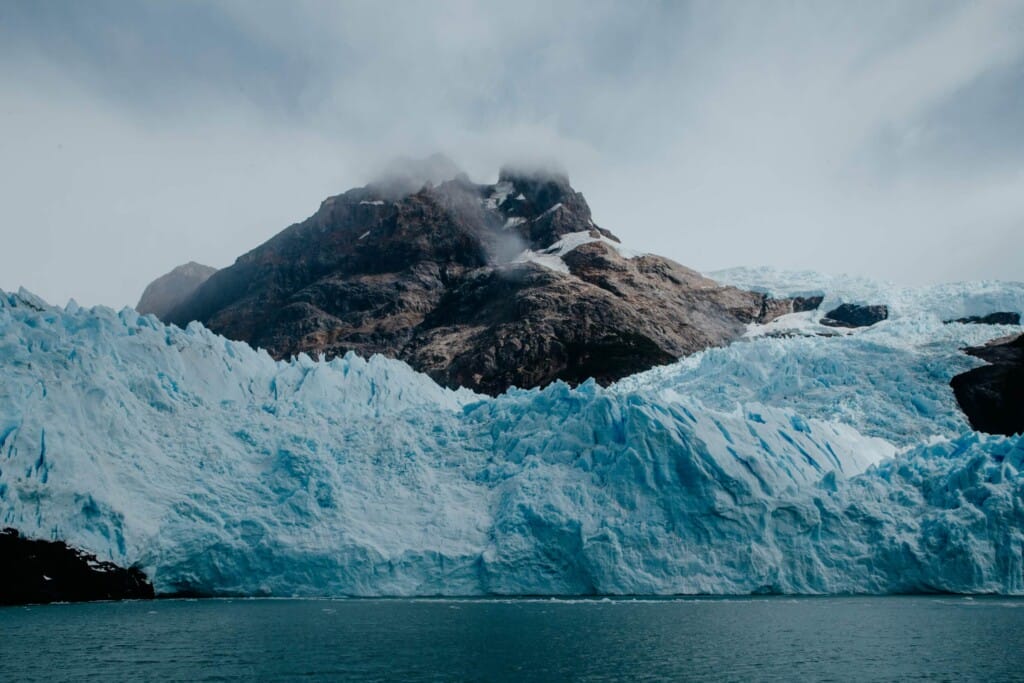
All of the Patagonia parks until now have been in Northern Patagonia, in the lakes district.
Los Glaciares is in Santa Cruz in Austral Patagonia (much further south).
Los Glaciares is one of the most beautiful parks on this list and home to two of Argentina’s most popular destinations: the Perito Moreno Glacier and the hiking capital El Chalten.
I recommend spending a couple days in the small city of El Calafate (where you’d fly into) to see Perito Moreno.
TIP | If you’ll be spending 2 consecutive days in Perito Moreno for multiple tours, pay for both days together to receive a discount.
From here, take the bus to El Chalten for at least 3-4 days and hike Argentina’s most beautiful hiking trails.
El Chalten makes up the northern portion of the park and is Argentina’s hiking capital.
Read more with my guide to El Chalten trekking.
When to visit Parque Nacional Los Glaciares
Late spring through early fall are the best months to visit Los Glaciares, for obvious reasons.
Summer is the absolute best with both warm temperatures and long days with the most sunlight to take advantage of for the day hikes.
Just know that in January, the peak of summer, there will be a lot of tourists as most of January takes their holidays then. Perito Moreno is one of the top destinations in Argentina so if visiting then book hotels and tours in advance.
It’s possible to visit during winter but you have to really love snow and the cold. If this isn’t you, then wait for spring.
14. Tierra del Fuego National Park

At the very end of the world, Tierra del Fuego National Park is located at the very southernmost tip of Argentina and one of the top Ushuaia attractions.
Use the city of Ushuaia as your base, which is just 12 kilometers from the park’s gates.
Tierra del Fuego is the only park to feature marine, mountains, and forest ecosystems.
In turn it features a diverse array of wildlife and activities.
The park houses some of the best day hikes in Ushuaia apt for all skill levels here so pack your boots.
There is a visitor center inside the park with a snack bar, public restrooms and a killer view.
Read More: A Guide to Visiting Parque Nacional Tierra del Fuego
15. Honorable mention: Peninsula Valdes

Peninsula Valdes is not one of Argentina’s national parks but I’ll never understand why. It’s one of the country’s most beautiful nature destinations.
So, I’m taking the artistic liberty of including it here in this list.
The closest city is Puerto Madryn, book your flight here but avoid the temptation to use it as your base like most do.
Puerto Madryn is actually quite a drive from the peninsula and not exactly easy on the eyes.
Instead, base yourself on the peninsula itself in the tiny village Puerto Piramides.
If you’d still prefer to base yourself in the city, read this guide on the best things to do in Puerto Madryn.
If you plan your visit to the right time of the year you’ll see penguins, sea lions, elephant seals, southern right whales and orcas.
It’s a wildlife lovers paradise.
Read about how we spent four days on the Peninsula Valdes and the most exciting Puerto Madryn excursions for some inspiration.
I guarantee you’ll want to plan a trip to Argentina’s Atlantic Coast.
Argentina Travel Resources
- BOOK A CONSULTATION | I offer one-on-one travel consultations to help you plan your trip to Argentina. Pick my brain to get a local’s insight. Click here for more information.
- MY MAP | Buy my interactive map with 300+ pins to have access to the city as I see it. It is an invaluable resource. See more here about how it works.
- AIRPORT TRANSFERS | Having a driver waiting for you is ideal for a stress free arrival, Welcome Pickups is the best option for a driver from Ezeiza or Aeroparque.
- TRAVEL INSURANCE | Always travel insured. Anything can happen anywhere and it is scarier and costlier in an unfamiliar country. SafetyWing’s Essential Plan covers unexpected travel and medical emergencies and even offers add-ons like electronics theft or adventure sports. It is the best if you’re coming on vacation. If you’re coming as a digital nomad or an extended stay, you need their Complete Nomad Plan which also covers routine check ups, maternity, mental healthcare and more. Read more: Health Insurance in Argentina
- PHONE PLAN | These days, traveling with data is essential. Especially in Argentina where everything is managed on Instagram and WhatsApp. I recommend this E-SIM card. It’s hassle-free and affordable, for more read how to get an Argentina sim card.
- ACCOMMODATION IN ARGENTINA | booking.com is the most common hotel site used in Argentina and it’s where you’ll find the most options.
- RENTAL CARS | I love to travel Argentina via road trip, Discover Cars is a great platform to compare different rates and providers.
- BUS TICKETS | Check Busbud for long distance bus routes and tickets.
- VPN | If you’ll be using a public WiFi connection and want to secure your data, I highly recommend using a VPN, I personally use and have had a good experience with ExpressVPN. I also use it to access Hulu and American Netflix from Argentina.
- FLIGHTS | Always check Google Flights and Skyscanner for flights to and within Argentina. Aerolineas Argentina is the local airline with the most routes. FlyBondi and Jetsmart are two budget airlines with dirt-cheap prices (but expect to pay for every add-on like luggage).
Argentina National Parks
These are my favorite national parks in Argentina! Of those I’ve visited, it’s impossible to pick a favorite.
The stunning beauty of the glaciers, the power of Iguazu, the rainbow colors of the Cardones in the Northwest, Argentina does not disappoint in its diversity.
Have you visited any of these parks? If so let me know your favorite in the comments! If not, what’s next on your bucket list?



A great list! We’ve traveled all around Argentina (except NW), and visited the majority of those! 🙂
Thanks for commenting! I hope you can make it to the NW someday, it’s stunning 🙂
nice article thank you.
one thing though, Switzerland is 41 000 sq km, so Ibera national park is not the size of the this country, only a third, roughly 😉